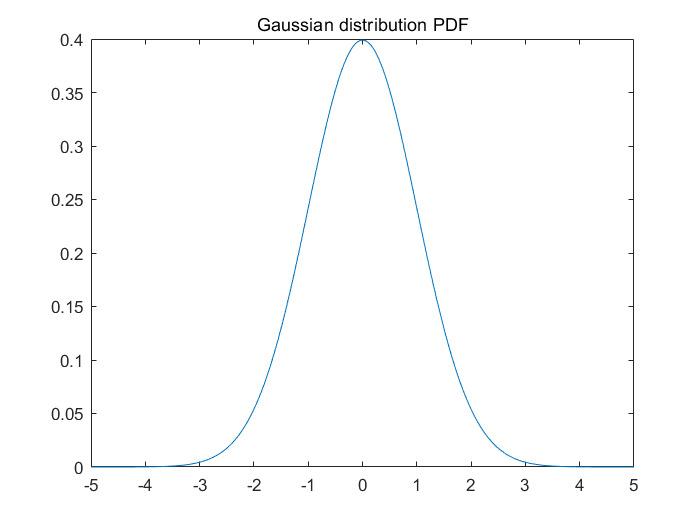GaussianBlur
이 전에는 Blur 처리를 간단한 방법으로 만들었지만, 좀 더 자연스럽게 만들기 위해 Gaussian함수를 사용해서 만들어 보자
이 분포가 가우시안 분포도이다. 이 분포도를 활요해서 중간 부분을 좀 더 강하게 블러 해준다.
Shader
104_GaussianBlur.fx
#include "00_Global.fx"
#include "00_Light.fx"
float2 PixelSize;
struct VertexOutput
{
float4 Position : SV_Position;
float2 Uv : UV;
};
VertexOutput VS(float4 Position : Position)
{
VertexOutput output;
output.Position = Position;
output.Uv.x = Position.x * 0.5f + 0.5f;
output.Uv.y = -Position.y * 0.5f + 0.5f;
return output;
}
float4 PS_Diffuse(VertexOutput intput) : SV_Target
{
return DiffuseMap.Sample(LinearSampler, intput.Uv);
}
const int GaussBlurCount = 6;
static const float Weights[13] =
{
0.0561f, 0.1353f, 0.2780f, 0.4868f, 0.7261f, 0.9231f,
1.0f,
0.9231f, 0.7261f, 0.4868f, 0.2780f, 0.1353f, 0.0561f
};
float4 PS_GausianBlurX(VertexOutput input) : SV_Target
{
float2 uv = input.Uv;
float u = PixelSize.x;
float sum = 0;
float4 color = 0;
for (int i = -GaussBlurCount; i < GaussBlurCount; i++)
{
float2 temp = uv + float2(u * (float) i, 0.0f);
color += Weights[6 + i] * DiffuseMap.Sample(LinearSampler, temp);
sum += Weights[6 + i];
}
color /= sum;
return float4(color.rgb, 1.0f);
}
float4 PS_GaussianBlurY(VertexOutput input) : SV_Target
{
float2 uv = input.Uv;
float v = PixelSize.y;
float sum = 0;
float4 color = 0;
for (int i = -GaussBlurCount; i <= +GaussBlurCount; i++)
{
float2 temp = uv + float2(0.0f, v * (float) i);
color += Weights[6 + i] * DiffuseMap.Sample(LinearSampler, temp);
sum += Weights[6 + i];
}
color /= sum;
return float4(color.rgb, 1);
}
struct PixelOutput_GaussianBlur2
{
float4 Color0 : SV_Target0;
float4 Color1 : SV_Target1;
};
PixelOutput_GaussianBlur2 PS_GaussianBlurMrt(VertexOutput input)
{
PixelOutput_GaussianBlur2 output;
float2 uv = input.Uv;
float u = PixelSize.x;
float sum = 0;
float4 color = 0;
for (int i = -GaussBlurCount; i < GaussBlurCount; i++)
{
float2 temp = uv + float2(u * (float) i, 0.0f);
color += Weights[6 + i] * DiffuseMap.Sample(LinearSampler, temp);
sum += Weights[6 + i];
}
color /= sum;
output.Color0 = float4(color.rgb, 1);
uv = input.Uv;
float v = PixelSize.y;
sum = 0;
color = 0;
for (int j = -GaussBlurCount; j <= +GaussBlurCount; j++)
{
float2 temp = uv + float2(0.0f, v * (float) j);
color += Weights[6 + j] * DiffuseMap.Sample(LinearSampler, temp);
sum += Weights[6 + j];
}
color /= sum;
output.Color1 = float4(color.rgb, 1);
return output;
}
Texture2D GaussianMrt[2];
float4 PS_GaussianCombined(VertexOutput input) : SV_Target
{
float4 color0 = GaussianMrt[0].Sample(LinearSampler, input.Uv);
float4 color1 = GaussianMrt[1].Sample(LinearSampler, input.Uv);
return float4((color0.rgb + color1.rgb) * 0.5f, 1.0f);
}
technique11 T0
{
P_VP(P0, VS, PS_Diffuse)
P_VP(P1, VS, PS_GausianBlurX)
P_VP(P2, VS, PS_GaussianBlurY)
P_VP(P3, VS, PS_GaussianBlurMrt)
P_VP(P4, VS, PS_GaussianCombined)
}
X축과 Y축을 계산한 뒤, 그 값들을 섞어준다.
GaussianBlur Class+
GaussianBlur2.cpp
void GaussianBlurDemo2::Initialize()
{
Context::Get()->GetCamera()->RotationDegree(20, 0, 0);
Context::Get()->GetCamera()->Position(1, 36, -85);
((Freedom *)Context::Get()->GetCamera())->Speed(50,2);
Performance performence;
shader = new Shader(L"96_Billboard.fxo");
float width = D3D::Width(), height = D3D::Height();
renderTarget[0] = new RenderTarget((UINT)width, (UINT)height);
renderTarget[1] = new RenderTarget((UINT)width, (UINT)height);
renderTarget[2] = new RenderTarget((UINT)width, (UINT)height);
depthStencil = new DepthStencil((UINT)width, (UINT)height);
viewport = new Viewport(D3D::Width(), D3D::Height());
render2D = new Render2D();
render2D->GetTransform()->Scale(355.0f, 200.0f, 1);
render2D->GetTransform()->Position(200.0f ,150.0f , 0);
render2D->SRV(renderTarget[0]->SRV());
postEffect = new PostEffect(L"104_GaussianBlur.fxo");
sky = new CubeSky(L"Environment/GrassCube1024.dds");
Billboards();
Mesh();
Airplane();
Kachujin();
KachujinCollider();
KachujinWeapon();
PointLighting();
SpotLighting();
}
void GaussianBlurDemo2::PreRender()
{
renderTarget[0]->PreRender(depthStencil);
viewport->RSSetViewport();
// Render
{
sky->Render();
Pass(0, 1, 2);
wall->Render();
sphere->Render();
brick->Render();
cylinder->Render();
stone->Render();
cube->Render();
floor->Render();
grid->Render();
airplane->Render();
kachujin->Render();
weapon->Render();
billboard->Render();
}
Vector2 PixelSize = Vector2(1.0f / D3D::Width(), 1.0f / D3D::Height());
postEffect->GetShader()->AsVector("PixelSize")->SetFloatVector(PixelSize);
// MRT
{
RenderTarget* temp[2];
temp[0] = renderTarget[1];
temp[1] = renderTarget[2];
RenderTarget::PreRender(temp, 2, depthStencil);
postEffect->Pass(3);
postEffect->SRV(renderTarget[0]->SRV());
postEffect->Render();
}
// Combined
{
renderTarget[0]->PreRender(depthStencil);
ID3D11ShaderResourceView* srvs[2];
srvs[0] = renderTarget[1]->SRV();
srvs[1] = renderTarget[2]->SRV();
postEffect->Pass(4);
postEffect->GetShader()->AsSRV("GaussianMrt")->SetResourceArray(srvs, 0, 2);
postEffect->Render();
}
}
void GaussianBlurDemo2::PostRender()
{
postEffect->Pass(0);
postEffect->SRV(renderTarget[0]->SRV());
postEffect->Render();
render2D->Render();
}
두개의 SRV를 받은 뒤, Shader의 Combine의 값으로 갖고온다.
이렇게 갖고오게 되면

전보다 조금 더 자연스럽게 나온다.
